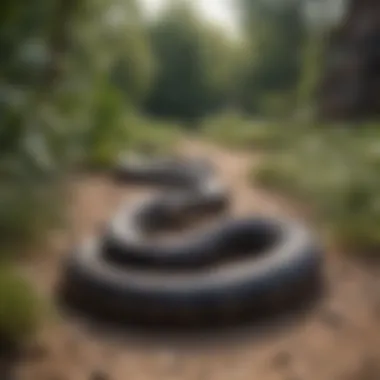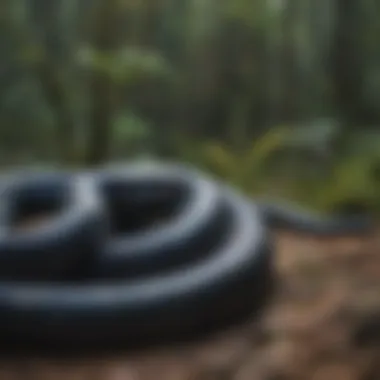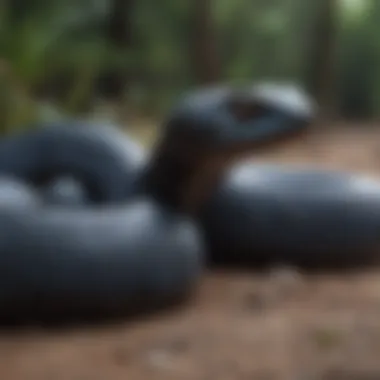Effective Strategies to Deter Black Racer Snakes


Intro
The black racer snake, a common inhabitant of various ecosystems across North America, may be a source of concern for some residents due to its speed and adaptability. Understanding how to keep these snakes away requires first looking into their characteristics and behavior. By exploring resilient ways to deter black racers, individuals can create a more secure outdoor space while also respecting the ecological importance of these serpents.
Animal Species Profile
Prolusion to the Animal Species
The black racer snake, scientifically known as Coluber constrictor, is a non-venomous species prevalent in the Eastern United States. Known for their agility, these snakes are often found in habitats that offer ample cover. It's important to understand their nature for effective deterrence. When undermined in their territories by human activities, such practices can lead to issues like venomous species encroachment.
Physical Characteristics and Appearance
Black racer snakes can easily be recognized by their sleek black bodies and white chins. An adult typically measures between 3 to 5 feet long, with some variations in size. Their glossy scales create a streamlined frame, ideal for quick movements through grass or underbrush. They also have small, round eyes made for precision viewing.
Natural Habitat and Distribution
This species primarily thrives in a range of environments, including forests, grasslands, and suburban areas. They are especially prevalent in regions where humans provide breaks in dense vegetation. Black racers are found in the continental US, mapping a wide distribution from southern Maine down to Florida, across the Midwest, and all the way to eastern Texas.
Behavior and Social Interactions
Black racer snakes are naturally solitary, primarily engaging with others during mating season. Known for their flight response, they are quick to vanish when encountering humans or larger animals. For deterrence, understanding how these snakes prefer avoidence is key. High-speed movement and quick reflexes mean they will remain elusive if they identify even slight disturbances.
Importance of Understanding Snake Behavior
To effectively deter black racer snakes, recognize and respect their habitat preferences and natural behavior.
Understanding snake behavior is beneficial not only for safety but also for making informed decisions about one's outdoor space. Awareness of their tempermants can lead to the implementation of strategies that effectively minimize their presence.
Practical Measures for Deterrence
Knowing how to keep these snakes away does not imply harm but often involves strategic adjustments. Here are some actions one can consider:
- Landscaping Modifications: Keep yards clear of excessive vegetation and debris.
- Habitat Alterations: Fill in burrows and any water sources, as black racers thrive where there is moisture.
- Repellents: Some commercial repellents may discourage snakes, but base their efficacy on user reviews and experiences. Maintaining awareness in your community helps with proactive initiatives against snake habitation.
Creating a less inviting environment will lead to lower chances of frequent visits from these energetic creatures. Few modifications together cultivate a yard that focuses on minimal disturbance, keeping black racers at a distance.
Understanding Black Racer Snakes
Understanding black racer snakes is crucial for anyone living in areas where these reptiles may inhabit. Their characteristics, habitat preferences, and behaviors significantly influence how we can manage their presence. Black racer snakes are not necessarily a threat, but familiarizing oneself with their nature helps alleviate unnecessary fear and promote a healthy coexistence.
Characteristics of Black Racer Snakes
Black racer snakes belong to the colubrid family and are easily identifiable by their glossy black coloration and slender bodies. They can grow up to six feet long. However, the average length is closer to four to five feet. Their secretive nature often leads to a quicker darting response when disturbed. Understanding their appearance is significant, as mistaken identity can lead to unnecessary panic. Unlike many venomous snakes, black racers are non-venomous and pose no direct risk to humans or pets.
Habitat Preferences
Black racers are versatile in their habitat selection. They are often found in various environments, ranging from forests to grasslands and even suburban areas. They prefer places with ample cover like tall grasses, brushy areas, and low shrubs. Thus, these snakes thrive in locations that offer plenty of hiding spots and easy access to food sources.
Moreover, they are excellent climbers and may occasionally den in trees or shrubs. Knowing where black racer snakes usually reside can help residents modify their landscapes to discourage these snakes from making themselves at home.
Behavioral Traits
Black racer snakes display intriguing behavioral traits. They are diurnal, meaning they are most active during the day. This high level of activity makes them more visible. They often hunt for prey such as rodents and small birds, contributing to local ecological balance. Their speed can be misinterpreted as aggressiveness, but they typically will flee rather than confront a threat.
Interestingly, black racers are known for their unique defense mechanism: they may vibrate their tails, mimicking rattlesnakes to fool potential predators. Understanding these behaviors allows individuals to recognize the difference between a defensive act and actual aggression. Educating oneself on these essential traits can foster a better response when encountering a snake in the yard.
Recognizing the behaviors and characteristics of black racer snakes is critical for successfully implementing preventive measures.
Why It Is Important to Keep Them Away


Understanding the importance of keeping black racer snakes away entails advantages for your safety and that of the ecosystem surrounding you. It signifies a comprehensive awareness of how these snakes interact with their environment, as well as the consequences of their presence near inhabited areas. Proper management ensures a climate that is both pocket-friendly and protects local wildlife.
Safety Considerations
Safety is a primary concern when it comes to keeping these snakes at bay. While black racer snakes are generally non-venomous, encounters can still provoke fear, especially among individuals unacquainted with them. Trouble may ensue when pets or curious children happen upon these snakes, leading to potential bites as a defense mechanism. This results in both physical harm and psychological stress. A proactive approach of employing effective strategies to deter snakes plays a key role in enhancing the overall safety of your living environment.
Notably, proximity to water sources or heavy vegetation tends to attract snakes due to favorable conditions. This highlights the need for ongoing habitat management. Additionally, some people exhibit a severe phobia towards these reptiles, necessitating preventive measures. Fear should not dictate one’s enjoyment of outdoor activities and spaces—maintaining a snake-free area is a win-win scenario for everyone.
Impact on Local Wildlife
The presence of black racer snakes can significantly impact local wildlife, as their role in the ecosystem fulfills a dual purpose: they act as both predators and prey. On one side, these snakes feed on a variety of smaller creatures including rodents, frogs, and insects which creates a balance in local populations. However, to properly manage the ecosystem, it is vital to ensure that their numbers do not rise excessively in residential areas.
Relying too much on one predator can shift dynamics harmfully. For example, over concentrations can result in a decline in certain species, disrupting food chains. This imbalance may further lead to issues like increased crop damage from rodent populations that may then thrive without natural predation. By instituting effective measures to keep black racer snakes away, you not only protect your immediate area but preserve the intricate balance of the local environment.
The primary goal is to create an ecosystem that advocates coexistence while managing the risks associated with proximity to much-feared wildlife.
Landscape Management Techniques
Landscape management plays a critical role inkeeping black racer snakes away from residential areas. By applying certain techniques, homeowners can create an environment that is less hospitable for these snakes. Proper landscaping encourages beneficial wildlife while simultaneously deterring species that may pose a problem. Simple adjustments can greatly reduce the chances of snake encounters.
Maintaining a Trimmed Yard
A neatly manicured yard is pivotal in snake deterrence. Overgrown vegetation and tall grass create hiding spots that appeal to black racer snakes. Regularly trimming hedges, mowing lawns, and cutting back shrubs can significantly decrease the risk of snakes lingering around. This habit not only minimizes habitat options for snakes but also improves overall aesthetics of the property.
- Actionable tips for maintaining a trimmed yard:
- Mow grass at a height that is difficult for snakes to hide in, ideally below 3 inches.
- Remove any large rocks or logs, as these items can serve as shelter.
- Keep mulch and decorative stones tidy, as these can also provide cover.
Being proactive in yard maintenance is crucial. A regular upkeep schedule allows homeowners to observe any signs of wildlife activity, enabling early countermeasures.
Selecting Reptile-Repelling Plants
The integration of specific plants in landscaping provides a natural deterrent to snakes. Selecting plants that are less appealing to reptiles can enhance the effectiveness of your garden. Certain fragrances or textures in plants may repel black racers naturally.
Some plants to consider incorporating include:
- Marigold: Known for their pungent scent, which is off putting for landscaper snakes.
- Lavender: Also offer strong odorous properties that snakes typically avoid.
- Mint: Containing sharp scents, mint can deter many reptiles.
When choosing plants, it’s important to create a diverse garden environment. Besides adding beauty, using a variety of plants might confuse and redirect snakes away from human dwellings. The correct choice of flora not only fosters a healthy ecosystem but also acts as a natural barrier.
Creating Barriers and Fencing
Establishing physical barriers can help insulate your home from possible snake entry. Strategies include erecting fences that are either made of smooth surfaces or buried underground.
Consider the following approaches:
- Snake-proof fencing should be at least 3 to 4 feet high and buried at least 1 foot underground. This method discourages both climbing and burrowing.
- Smooth surface fencing makes it difficult for snakes to gain traction, a crucial aspect for keeping them at bay. It is also sensible to select fire-retardant materials, which aids in safety.
- Ensure to routinely check the fencing for signs of damage or gaps.
”Landscaping adjustments play a pivotal role not just in aesthetics, but also in preserving safe living spaces.” The effectiveness of barriers lies not only in installation but continuous oversight. Exemplary monitoring and maintenance will ensure maximum impact over the long run.
By merging simple landscape management techniques like trimming yards, selecting repelling plants, and erecting effective barriers, homeowners dramatically enhance their chances of keeping black racer snakes away. Being proactive in these areas not only enhances safety but establishes the foundation for more harmonious living with wildlife.
Habitat Modifications
Habitat modifications play a critical role in deterring black racer snakes from residential areas. By making systematic adjustments to the environment, we can not only dissuade snakes from returning but also create a less favorable condition for their habitat. The larger implications of managing the landscape compel us to take active measures to improve safety for pets and residents alike, while also fostering an atmosphere of responsible wildlife management.
Removing Debris and Hiding Spots
One fundamental action in habitat modification is to clear away debris and potential hiding spots. Black racer snakes gravitate towards environments that offer shelter. Fallen leaves, yard clippings, and piles of stones create perfect conditions for them to linger. By consistently removing these materials, homeowners can drastically reduce the likelihood of sightings.


Additionally, consider the spaces under decks and patios; these cramped quarters can become a sanctuary for various reptile species typified by a lack of light and access. Furthermore, keeping woodpiles neatly contained or relocated can also lower a snake's chance of locating an ideal resting area.
This change in landscape management transforms your yard into a less inviting location for black racer snakes. Maintain vigilance in yard upkeep to prevent the accumulation of unexpected debris.
- Effective strategies to clear debris involve:
- Managing garden waste promptly.
- Storing firewood in dry areas, lifted off the ground.
- Routinely inspecting hidden areas and fencing.
Controlling Water Sources
Addressing water sources has a significant impact on snake habits, particularly black racer snakes, as they value accessibility to moisture for hydration. Overly controlled irrigation systems can create unwarranted water pooling, which attracts them. Inspection of gutters and drainage systems is prudent for any homeowner aiming to deter these visitors.
Collect rainwater in barrels, but be sure these are properly screened to prevent snakes from reaching the water. On the contrary, removing other excess water arrangements like bird baths or periodically emptying blocked trays from outdoor plants helps minimize available sources.
Adopting methods to regulate water systems ultimately provides further deterrence from snail's family members that thrive in favorable hydrological conditions.
Modifications targeting water retention directly reduce the probabilities of these snakes taking up residence, granting considerable control over human–wildlife interactions.
Achieving an effective balance of yard visibility, alongside proper drainage, assists in fabulating a future with fewer snake encounters. It's not merely a personal preference; it contributes positively to the ecosystem as well, promoting healthier environments devoid of unwanted serpentine inhabitants.
Effective Repellents and Deterrents
Detering black racer snakes effectively may depend significantly on the appropriate use of repellents and deterrents. Understanding these can lead to a more proactive stategy against their presence. Evaluating how these products work as well as their unique benefits becomes essential for homeowners and community members, especially in areas with a higher snake activity. Proper utilization can result in enhanced peace of mind about wildlife interactions while maintaining a respectful relationship with the snake population.
Commercial Snake Repellents
Commercial snake repellents are available in various forms, including sprays, granules, and powders. These products generally contain substances specifically designed to interfere with the sensory capabilities of snakes, making the environment less appealing. Effective repellents often rely on strong scents or irritants that discourage snakes from entering certain areas.
Key Features to Consider
- Ingredients: It's paramount to read labels carefully. Natural oils may be more sought-after because they are tactful to other forms of wildlife and can be better for the surrounding.
- Distribution Method: Some products will last longer or are more easily applied in large areas. This factor can be vital based on your property size and layout.
- Environmental Safety: Ensure that the product chosen doesn’t pose risks to pets or beneficial insects. Toxic substances can disrupt the local ecosystem. It may require vetting from environmental sectors to find suitable alternatives.
Usage Tips
- Application Frequency: Follow product instructions, but usually, a regular reapplication after rain is crucial.
- Point of Application: Areas that are frequently transitioned to, such as near entrances to gardens or doorways, should be prioritized.
Choosing the right commercial snake repellent can disenchant wandering racer snakes, thereby protecting your home.
Natural Remedies
Natural remedies for keeping black racer snakes away provide an environmentally friendly alternative to chemical repellents. These alternatives utilize more organic materials that can be benign to both humans and wildlife alike.
Common Natural Repellent Suggestions
- Cinnamon Oil: This oil odorous snakes may find unwelcoming. It could be diluted with water in a spray bottle for distribution.
- Clove Oil: Similar its work to other essential oils, clove oil may deter geplements and enhance repelentd feelings.
- Garlic: Planting garlic bulbs or utilizing garlic powder in areas where snake activity is noticed can create a strong smell that snakes dislike.
- Peppermint Oil: Known not just for pleasing aromas, peppermint oils can surprisingly function to diminish possible attraction.
Considerations and Practical Advice
- Maintaining Efficacy: These natural remedies may require re-application throughout summer months or rainy days to sustain effectiveness.
- Trial and Error: Not every individual remedy will work the same for every homeowner or location; some experimentation may yield better personalized results.
Using these repellents and remedies reflects a responsible approach to wildlife interactions. This method aligns with creating an environment that discourages snakes naturally without causing harm or undue distress shouldering both homeowner desires and ecological balance.
Community Awareness and Cooperation
Community awareness plays a crucial role in effectively keeping black racer snakes away from your environment. Individual efforts often yield diminishing returns when isolated from the broader context of community initiatives. Collaborative education provides a strong foundation for creating a safer and more vigilant neighborhood regarding snake presence. When the community comes together to address wildlife concerns, it elevates not just individual initiatives but fosters a culture of proactive management.
A collective mindset helps identify potential snake habitats and influences responsible property management practices. Not every home may implement the same degree of strictness in landscape maintenance or waste management. When neighbors share knowledge, the gainer potential becomes substantial.
Educating Neighbors


Educating neighbors about black racer snakes is essential. Many people have the wrong perception of snakes as dangerous creatures to be feared. Sharing factual information concerning black racer snakes—such as their behavioral traits, habitat preferences, and actual risks—expands understanding. Promotion of this knowledge can be achieved through informal discussions, neighborhood meetings, or even local social media groups.
Consider distributing pamphlets or engaging in community workshops that illustrate important aspects like:
- Common misconceptions: Widely held beliefs can be counter-productive. Addressing myths along with patience jogs understanding permanently.
- Recognition of black racer snakes: Not everyone can easily differentiate them from non-threatening species. Visual aids—or even a short presentation detailing their characteristics—can profoundly assist.
- Information about repellent methods: Explain practical steps people can take immediately, from landscaping choices to commercial repellents, to help deter snakes.
Establishing a network for newsletter-style updates can also inform all residents about snake sightings. Actively keeping conversations alive maintains awareness.
Local Guidelines and Policies
Local guidelines and policies may impact how the community can effectively work together in keeping black racer snakes away. Checking with municipality or county ordinances offers clarity on both residential expectations and cooperative responsibilities. There might be specific rules regarding property maintenance, waste disposal, and garden care related to wildlife management.
Consideration of these rules ensures not only compliance but helps the community collectively enforce safety measures. Actively advocating for local ordinances that prioritize habitat management—through proper signage and community clean-ups—enables people to protect their properties with collective vigilance.
Fact: Many regions are implementing wildlife management policies designed to educate homeowners about cohabitating responsibly with local fauna. These rules are intended to reduce human-wildlife conflicts effectively.
In addition, local policies can facilitate additional training for volunteers. Engaging with wildlife agencies for organized trainings can prepare entire neighborhoods in observing, identifying, and dealing appropriately with wildlife issues, including black racer snakes.
Harnessing both community efforts and existing guidelines fosters a comprehensive approach. Thus, it accounts for responsibilities shared by all, allowing effective deterrence of unwanted snake populations and harmony with nature.
Monitoring and Reporting Sightings
Monitoring and reporting the sightings of black racer snakes plays a crucial role in maintaining a safe environment. By diligently tracking their activity, individuals can better understand when and where snakes are active. Therefore, this information not only helps in the effective implementation of prevention strategies but also enrichens the collective understanding of local wildlife interactions. Keeping these records may help detect patterns in snake movement, establishing areas of concern where further intervention may be needed.
Documenting Snake Activity
The importance of documenting snake activity cannot be understated. Keeping detailed records of observations helps homeowners understand how often they encounter black racer snakes. It can include everything from date and time of the sighting to description of the snake's behaviors. This needs to be done consistently to create reliable data.
Key aspects to consider when documenting snake activity are:
- Visual Descriptions: Note the size, color, and any unique features.
- Habitat Description: Circle out the environment, such as yard type, nearby water sources, or structures providing shelter.
- Behavioral Observations: Whether the snake is foraging, basking, or heading to a specific place.
Owning a comprehensive record can assist in pinpointing recurring locations or seasons with higher snake activity. This knowledge enables better preparedness as well as more targeted remediation activities.
Reaching Out to Wildlife Agencies
Wildlife agencies can be an essential resource for dealing with black racer snakes. Engaging with them when a sighting occurs can provide valuable insights into how to better manage the interaction with this species. They can offer expertise on local snake behavior and how to handle potential encounters safely.
Benefits of contacting these agencies include:
- Professional Guidance: Get reliable advice on avoiding harmful situations.
- Local Regulations: Understanding regulations regarding wildlife, as there can be legal considerations if removal is needed.
- Community Insights: Insights based on broader trends about sightings within the area.
In many cases, these organizations may also have rehabilitation programs or further educational resources, promoting a community-oriented approach toward snake encounters.
End
Keeping black racer snakes away is vital for various reasons. First, their ability to thrive in multiple environments makes it crucial for individuals to understand effective prevention methods. Black racers are not inherently dangerous to humans, but maintaining distance helps minimize aversions and accidental encounters.
Summarizing Effective Strategies
In summary, it is essential to implement the right strategies to deter black racer snakes. Adjustments in landscaping can significantly lower their habitat appeal. Here are some effective techniques to consider:
- Maintain a trimmed lawn: Regularly mowing grass reduces hiding spots.
- Remove debris: Clearing wood piles and brambles keeps the area less inviting.
- Use repellents: Both commercial and natural options are available for added protection.
- Mind sources of water: Avoid stagnant water that attracts snakes.
These measures can considerably decrease the likelihood of snakes entering your property.
Encouraging Responsible Wildlife Coexistence
Rather than viewing black racer snakes as mere nuisances, fostering understanding of their ecological role can benefit both humans and wildlife. Encourage your community to appreciate these creatures for their contributions to controlling rodent populations. By:
- Educating neighbors about snake habits and benefits of snakes in the ecosystem.
- Encouraging reporting and monitoring of snake sightings for better awareness.
Recognizing that coexistence is possible will enhance safety and promote a harmonious living environment.
Understanding wildlife contributes to responsible stewardship in our communities.
Balancing human interests and wildlife needs fosters biodiversity while keeping homes safe from unwanted wildlife intrusions.







